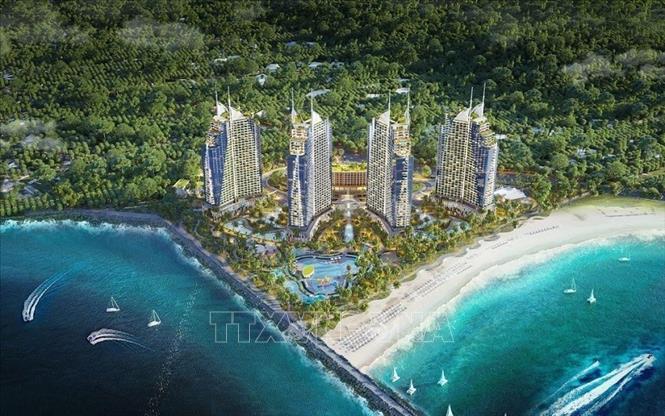Nguồn cung bất động sản nghỉ dưỡng có cơ hội cải thiện khoảng 20%

The real estate market in Vietnam has seen a surge in the development of resort properties since 2015. With annual growth rates of up to 50%, the industry experienced a significant downturn in 2018 due to various factors. However, recent strong growth in the tourism sector has created optimism for a potential recovery in the resort real estate segment.
While other sectors have shown signs of recovery, the tourism and resort real estate market still lags behind. The tourism industry has experienced robust growth, nearing pre-pandemic levels. For example, in the first two months of 2024, Vietnam welcomed over 3 million international tourists, a 68.7% increase compared to the same period last year and a 98.5% increase compared to 2019.
In order to boost the resort real estate market, it is crucial to complete legal frameworks, announce development plans, accelerate infrastructure projects, and leverage the momentum of the tourism industry. The government’s decision on “Vietnam’s tourism development strategy until 2030” will serve as a driving force for businesses to expedite their projects, thereby introducing new supply to the market and catching up with the overall market recovery.
Furthermore, the government’s Decree No. 10/2023/NĐ-CP, which amends and supplements certain provisions of the Land Law, will remove barriers to the issuance of ownership certificates for condotels (hotel apartments) and officetels (office-residential units). This policy amendment is expected to provide favorable conditions for investors and support the revitalization of the real estate market.
According to industry experts, the resort real estate market in Vietnam still holds great potential for future development. With the growing demand for tourism and the interest from investors, sustainable development requires a focus on planning and project development in order to preserve and respect the natural landscape.
In addition to providing a conducive environment for tourism and resort activities, developers need to adapt to new trends, offer unique experiences, and provide products that cater to the real needs of customers. Product diversification is also essential to meet the demands of different customer segments, ranging from luxury beach villas to convenient resort apartments.
Statistics from the Vietnam Association of Real Estate Brokers (VARS) show that from 2015 to 2017, the tourism sector witnessed the development of numerous large-scale resort real estate projects, primarily located in Nha Trang, Da Nang, and Phu Quoc. These projects, developed by major real estate investors in collaboration with reputable global companies, showcased the distinct characteristics of each region. Condotels, in particular, saw a significant increase in supply during the years 2016-2017, with good absorption rates.
However, in 2018, the resort real estate market experienced a downturn due to internal challenges, such as legal issues surrounding condotel properties, operational capacity and commitments of developers, and pricing concerns. In addition, the impact of the COVID-19 pandemic in 2020 resulted in a freeze in the market and no transactions throughout 2021.
At the beginning of 2022, as the economy recovered and low-interest-rate capital flooded the market, speculation intensified, resulting in increased demand for real estate across all segments. Resort real estate swiftly embraced the post-COVID tourism wave for both domestic and international visitors. Major real estate companies unveiled plans for large-scale resort projects spanning hundreds to thousands of hectares, with investment amounts reaching billions of dollars.
However, this early optimism was short-lived as the real estate market showed signs of a slowdown in mid-May 2022. Tighter credit policies, corporate bond regulation, and other factors posed challenges to the financial market, leading to increased risks and interest rates. Easy cash flow, which had been available until the end of 2023, became scarce. Legal issues that had not been addressed resulted in the suspension of numerous real estate projects, particularly high-end resort developments.
As a result of the rapid development in previous stages, many businesses are now paying the price, as inventory levels have surged while new supply has significantly decreased. In 2023, there were only around 3,165 new resort real estate products, an over 80% decrease compared to 2022. Transaction volumes have also failed to recover as expected, with only 726 successful transactions recorded throughout 2023.
Currently, most projects are facing legal obstacles, preventing them from being put on the market. Meanwhile, existing inventory mainly consists of high-value and high-end products, which directly compete with distressed properties purchased by investors in previous years. In secondary markets, beach villas and resort shophouses also face liquidity challenges despite significant price reductions.
In conclusion, the resort real estate market in Vietnam holds significant potential for future development, driven by the high demand for tourism and the interest of investors. However, sustainable growth requires careful planning and project development to preserve and respect the natural landscape. Developers need to adapt to new trends, provide unique experiences, and diversify products to meet the needs of different customer segments. Despite recent challenges, the resort real estate market has the opportunity to improve by approximately 20% with the support of a recovering tourism industry and favorable government policies.
Visit Business Today for more financial news and insights.
